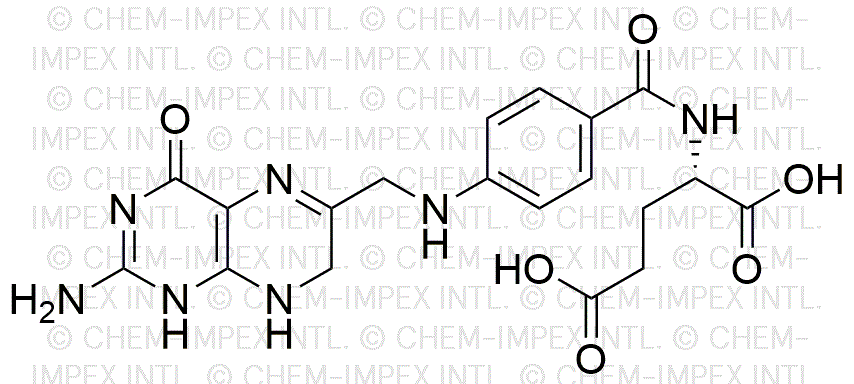Dihydrofolic acid is widely utilized in research focused on:
- Pharmaceutical Development: It serves as a precursor in the synthesis of folic acid, which is essential in developing medications for treating various conditions, including anemia and certain cancers.
- Biochemical Research: Researchers use it to study folate metabolism and its role in cellular processes, helping to understand diseases linked to folate deficiency.
- Nutrition Science: Dihydrofolic acid is important in formulating dietary supplements aimed at preventing deficiencies, particularly in pregnant women to reduce the risk of neural tube defects in infants.
- Microbiology: It is utilized in culture media for growing certain bacteria, allowing scientists to explore microbial metabolism and antibiotic resistance mechanisms.
- Genetic Studies: The compound is employed in experiments related to DNA synthesis and repair, providing insights into genetic disorders and potential therapeutic targets.
General Information
Properties
Safety and Regulations
Applications
Dihydrofolic acid is widely utilized in research focused on:
- Pharmaceutical Development: It serves as a precursor in the synthesis of folic acid, which is essential in developing medications for treating various conditions, including anemia and certain cancers.
- Biochemical Research: Researchers use it to study folate metabolism and its role in cellular processes, helping to understand diseases linked to folate deficiency.
- Nutrition Science: Dihydrofolic acid is important in formulating dietary supplements aimed at preventing deficiencies, particularly in pregnant women to reduce the risk of neural tube defects in infants.
- Microbiology: It is utilized in culture media for growing certain bacteria, allowing scientists to explore microbial metabolism and antibiotic resistance mechanisms.
- Genetic Studies: The compound is employed in experiments related to DNA synthesis and repair, providing insights into genetic disorders and potential therapeutic targets.
Documents
Safety Data Sheets (SDS)
The SDS provides comprehensive safety information on handling, storage, and disposal of the product.
Product Specification (PS)
The PS provides a comprehensive breakdown of the product’s properties, including chemical composition, physical state, purity, and storage requirements. It also details acceptable quality ranges and the product's intended applications.
Certificates of Analysis (COA)
Search for Certificates of Analysis (COA) by entering the products Lot Number. Lot and Batch Numbers can be found on a product’s label following the words ‘Lot’ or ‘Batch’.
*Catalog Number
*Lot Number
Certificates Of Origin (COO)
This COO confirms the country where the product was manufactured, and also details the materials and components used in it and whether it is derived from natural, synthetic, or other specific sources. This certificate may be required for customs, trade, and regulatory compliance.
*Catalog Number
*Lot Number
Safety Data Sheets (SDS)
The SDS provides comprehensive safety information on handling, storage, and disposal of the product.
DownloadProduct Specification (PS)
The PS provides a comprehensive breakdown of the product’s properties, including chemical composition, physical state, purity, and storage requirements. It also details acceptable quality ranges and the product's intended applications.
DownloadCertificates of Analysis (COA)
Search for Certificates of Analysis (COA) by entering the products Lot Number. Lot and Batch Numbers can be found on a product’s label following the words ‘Lot’ or ‘Batch’.
*Catalog Number
*Lot Number
Certificates Of Origin (COO)
This COO confirms the country where the product was manufactured, and also details the materials and components used in it and whether it is derived from natural, synthetic, or other specific sources. This certificate may be required for customs, trade, and regulatory compliance.


